|
Getting your Trinity Audio player ready...
|
I was recently in Peshawar to attend my younger brother’s wedding. It was a long time, more than a decade since there was a wedding in my family, so everybody was excited, including myself. After spending a week full of festivities and fun, when I came back to Rochester, all my American friends were excited to see the pictures and know the details of the wedding. I think Bollywood has done an amazing job of portraying Desi weddings to the world. (If Desi is a new word for you, the dictionary meaning of this word is “of, from or characteristic of India, Pakistan or Bangladesh.”)
There is no doubt that these weddings are some of the most fun domestic events carried out anywhere in the world. As I was showing the pictures and explaining traditions, I realized that I couldn’t do justice to the descriptions in bits and pieces and there is a lot to tell so it would be nice to put some of the information together as an essay for those who like reading.
Wedding events can have some variations depending on the local region but there are three primary events that essentially all Pakistani weddings have. These are called the Mehndi, Baraat and Walima. These are the rough equivalents of the western weddings’ rehearsal dinner, the wedding ceremony and reception, and the post- wedding brunch. In days before these events, there might be smaller gatherings called “Dholki’s” (Urdu word for a small drum) where the closer family members and friends get together.
After the three main events, there are usually dinners or lunches hosted by close family members and the number of people that attend these after-events are smaller. The first two main events that is the Mehndi and the Baraat are hosted by the bride’s family and the Walima is hosted by the groom and his family. The three events traditionally take place on consecutive days but it is not uncommon for the events to be spaced apart by a day or two either to allow for rest or travel or some other reasons such as non-availability of wedding venues.
Mehndi
Mehndi is the Urdu translation of the word Henna. Henna is a plant/shrub, the leaves of which are crushed into a brown powder. A pasty version of this powder is used to either dye hair or apply to skin in various patterns that make great temporary tattoos. This can be applied anywhere on the body but most commonly applied to the hands or feet in intricately beautiful designs.
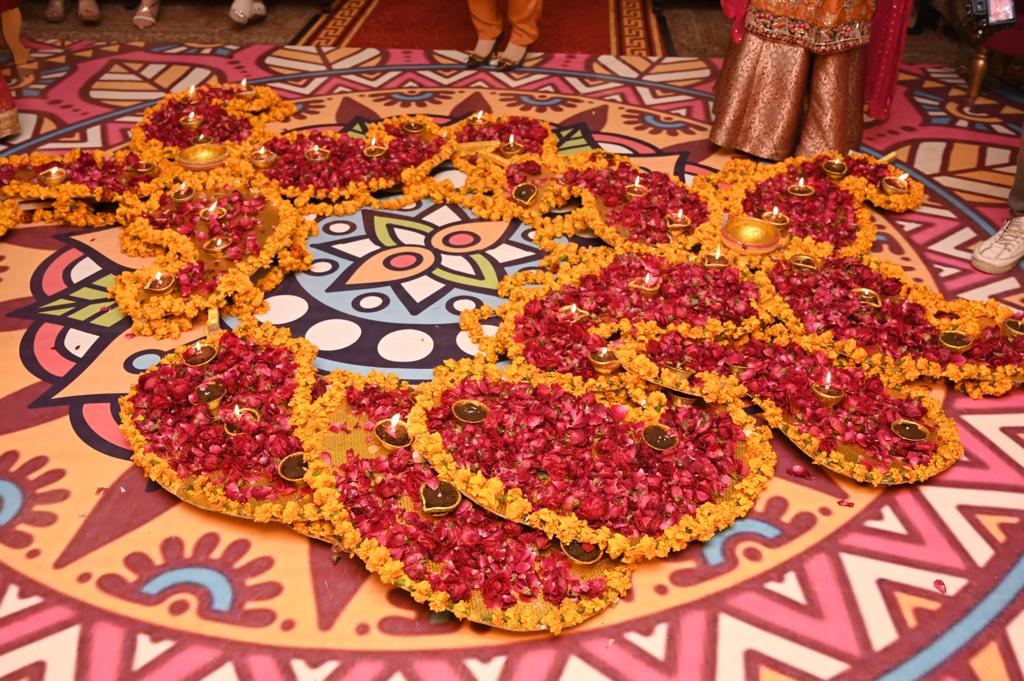
This first event of the wedding is named as such because the groom along with his family goes to the bride’s house and large, beautifully arranged trays of Mehndi are brought along. The girls apply Mehndi to each other and also to the bride’s hands and feet. The groom is brought in and sits right next to the bride and family members enjoy on the dance floor which is typically situated right in front of them.
This is the last night when the groom and bride will spend without each other. After this night, they are supposed to be together every night for the rest of their lives.
Baraat
This is the main event when the bride finally goes to the groom’s house. Baraat is also called Rukhsati, which means Departure (of the bride from her father’s home to the husband’s.) On this event, the groom goes, along with his family and friends in the form of a procession to the bride’s house or to another venue where they may be hosting the event.
Typically, they all gather at the groom’s house and then hop into their cars and go in a long queue together so that the passers by can tell that it’s a wedding procession. Some people will also turn their hazard lights on to signal that they are part of the procession. The groom’s car is dolled up with flowers. In olden days, this procession used to go on horses which is not done that commonly anymore but some people even today might arrange for the groom to enter the event venue on horseback.
Once the procession reaches the bride’s house, the Nikah ceremony takes place which is a solemn event when the Mullah (priest) recites the religious prayers and officially weds the two. Unlike in western weddings, there is no declaration by the priest for the groom to kiss the bride because public displays of physical affection are considered unacceptable in the society. After some dancing and a lavish meal, the bride says a teary goodbye to her family and goes to the groom’s house along with the procession.
Walima
This is an event hosted by the groom and his family. The marriage has already taken place by this time and the bride and groom are now together in hosting their guests. Since the previous two events are hosted by the bride’s family, this now is a chance for the groom to invite any guests that are closer to the latter family. This is a relatively simple event compared to the previous two.
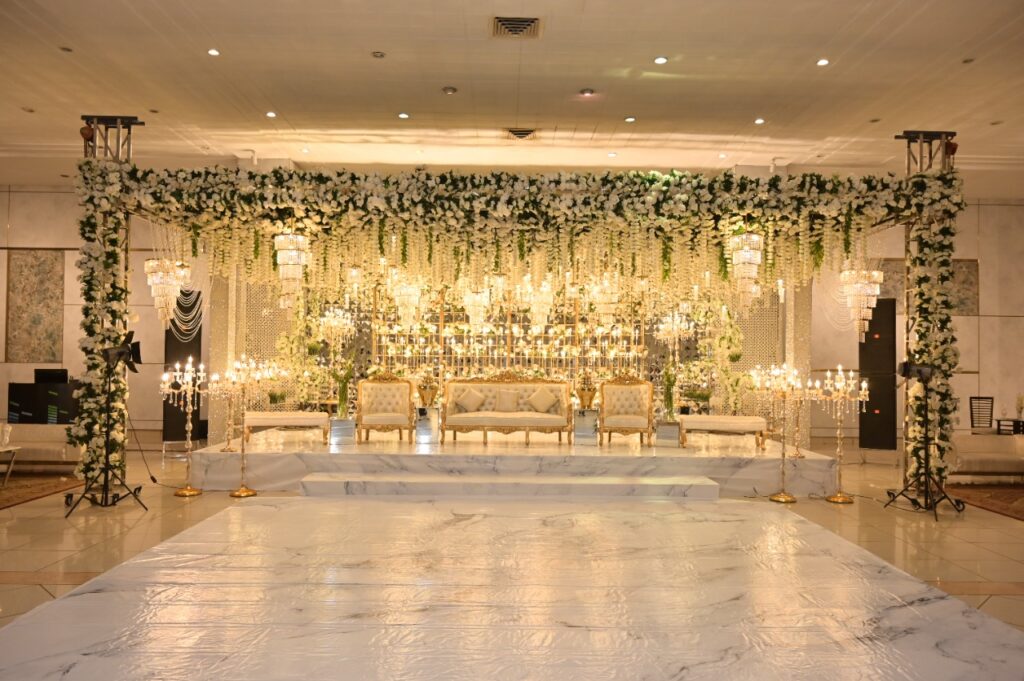
A common tradition is for the groom’s friends to ask the groom if the Walima is a “true” Walima or not. Those are code words to ask if they had sex on the night of the baraat or not. If the groom says Yes, then everybody rejoices. If the groom says No, then everybody tries to troubleshoot the reason which can range from the bride not feeling well to maybe being on her menstrual cycle or the groom may have some difficulty performing. If the groom is too shy or private to answer such a question, then people guess whether the Walima is “true” or not by his body language and whether he is appearing happy and joyful versus edgy, irritable and unfulfilled.
At different times during the main events, there are a number of traditions that are followed. These local traditions may vary depending on the region but I’m sure that you would enjoy reading about some of these.
“Drink some milk if you want to get married next”
This tradition typically takes place when the bride comes to the groom’s house for the first time as the Baraat procession brings her from her father’s house. She is given a glass of milk to take a sip from. The milk is mixed with nuts and honey, nicely warmed up and is truly delicious. She hands over the glass to the groom who also takes a sip. The glass of milk is now considered to have transformed into a potion that whoever drinks, will get married soon.
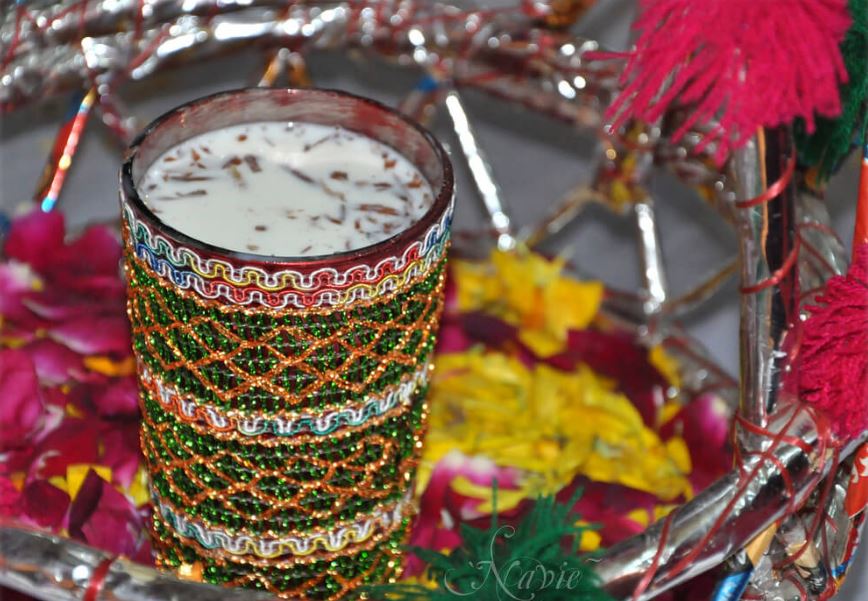
The men who are either the same age as the groom or younger, who are still unmarried, jump forward to get hold of the glass and take a few sips. The younger boys, who have hit puberty but are still too shy about getting married, nervously refuse the drink. The girls do not even take a look because a girl would look too “forward” if she openly declared that she wants to get married. The older men stand around joking how they are fed up with their spouses and how they should also take a sip and maybe it will open a new door for them too. Someone joked that I should take a sip but after a marriage gone sour, I decided to stay away from the sweet poison for as long as I could.
This tradition is very similar to the “Bouquet Toss” in a western wedding where the bride throws a bouquet over her shoulder and amongst the single bridesmaids, whoever catches it, gets the good omen of finding love and getting married next. As a bridesmaid, you are thinking that if it still doesn’t work for you and you still don’t get married, it’s still a good idea to try to catch it if you want to go home with a beautiful bouquet.
The Act of Throwing Money
At any of these events, there is always loud music. This is either a live band or more commonly, a DJ is hired who brings in all his equipment including loud speakers and the mixer. The DJ’s staff carry with them a large amount of cash. These are all in small bills stacked and stapled together. Each small bill carries the value, let’s say of a dollar bill (not in terms of the actual stock exchange rate but rather in terms of the local “spending power” value of the money.) Right in front of the music setup is a clear area, which is made into a dance floor.
The dance floor gets particularly busy at different moments during the event such as when the Mehndi trays are brought in or when the groom walks in for the first time accompanied by the groomsmen. This is when you have to buy some stacks of small bills (notes) and throw them in the air on top of the groom or other people who are dancing. There is a variety of ways in which the notes can be thrown with dexterity and some people particularly show off their money throwing skills. The DJ’s staff are very quick to bend down to the floor, the “note-pickers”, and they keep collecting the money and putting them back into their cash reservoir. This money ends up being a substantial portion of their earnings for the night and is loosely negotiated at the time of setting up the final rates for the job.
I had mixed feelings about this tradition. Since I have been living in America for the last two decades, I have been somewhat removed from the Pakistani wedding culture. I spoke to my younger brother who routinely goes to these weddings and throws money generously and proudly. I told him how I felt that this tradition is hard for me to carry out because we have always been taught the respect of money. Hard-earned money should not be thrown pompously like this when there might be people in the same neighborhood who are sleeping without having enough to feed their children. Life has shown us well-off people lose their money, sometimes instantly. There is nothing so miserable like a rich person going poor.
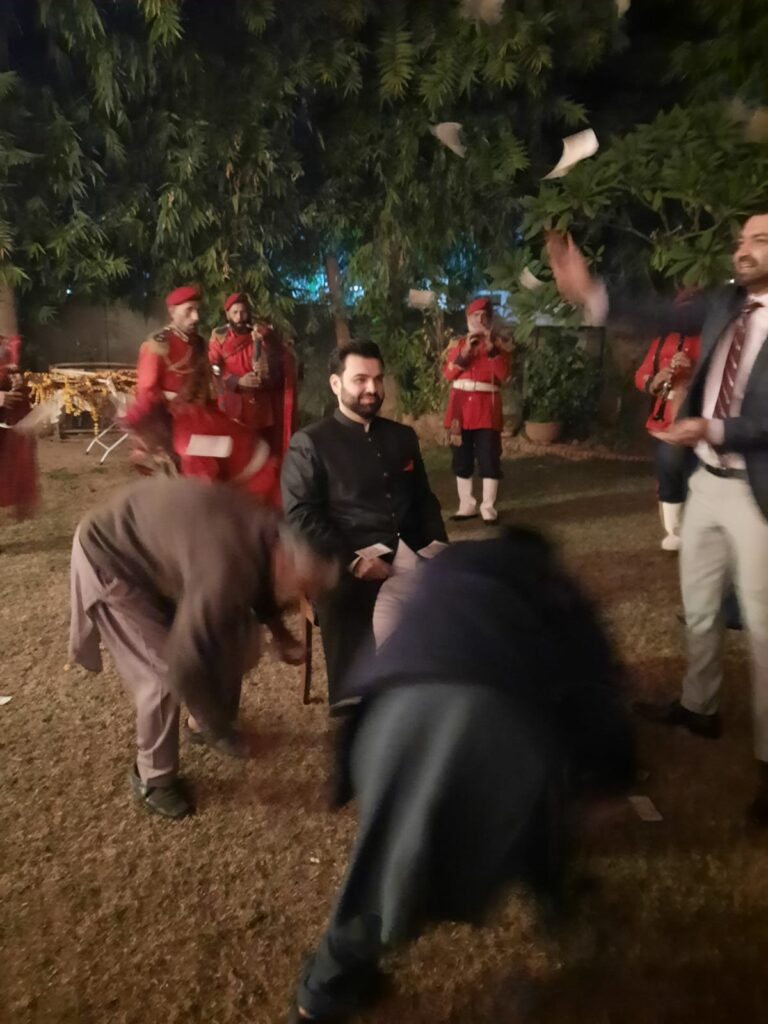
I have not seen any other culture having a tradition of throwing money except for men throwing money at strippers in a strip club. My brother rebuked me for my thought process and told me that I was perhaps overthinking it. He asked me to let a tradition remain a beautiful tradition and try not to put negative connotations to it. He told me that it is a way of showing your happiness and the tradition has been going on for, who knows how many centuries and whatever my pocket allows, I should partake in it.
Before the wedding, I had in my mind that I will not throw money. When the festivities began and people started dancing to loud music, the stage was set for close friends and family members to start throwing money. I resisted for a while but then started feeling awkward that I was so close to the groom being his older brother and was not participating in one of the old traditions. This is when I also bought a stack of notes and started throwing the money at him. To participate fully, I even handed over some cash to some of the teenagers for them to throw, thinking that if their parents did not like this practice, then I would be in trouble.
I thought to myself that this was an example of how difficult it is to stop yourself from doing what everybody else is doing even if you don’t want to. This “not doing” can sometimes be even more difficult than “doing” what other people are not doing. I was confused as to whether to act loyal to my culture and try to keep a tradition alive or to risk appearing a “stuck up” by not following it since it went somewhat against my own principles.
“Give us money if you want to spend the night with your bride.”
The night of the Baraat is the first night that the “just married” couple will spend together. Needless to say that this is the most important night perhaps of their entire lives. They are filled with excitement to finally be with each other and of course the prospect of making love for the first time. It doesn’t come that easy though.
From the time they are sitting on the wedding stage, the bridesmaids start asking the bridegroom for money in order to let him take the bride to his home. They traditionally also take away one of his shoes and do not give it back to him unless if he doles out some cash (Joota Chupai – “hiding of the shoe.”) There is haggling that goes on for quite awhile and no amount seems to make the girls happy. The groom, already burdened by the expenses of the wedding, tries to shortchange them. Once they agree on a certain amount, the girls finally give him back his shoe but to his consternation, when he brings her back home, the entry to the house is blocked by his own friends having the same demand. Another long negotiating session takes place and he gives the rest of his money to his friends to be able to finally spend some alone time with his new bride.
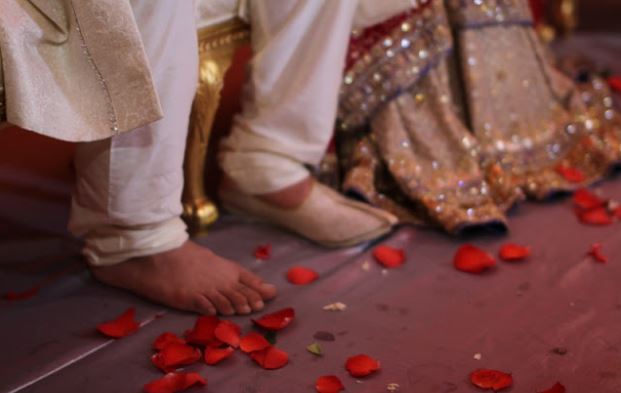
It doesn’t end there though. As he is about to finally enter the wedding room, his own cousins and other youngsters in the family block his way to the bedroom. His pockets already emptied out from previous encounters, now he turns to his friends to borrow some money to finally be left alone with his new wife. If this tradition starts becoming too prolonged, some elders usually ask for it to be curtailed because it is usually already a late hour in the morning and the newly married couple often have to wake up at a decent time the next day for a festive brunch.
The crying bride
As I was showing some pictures of the Rukhsati (the departure) to some of my American friends, they were curiously asking why the bride and her close family members were crying when she was leaving finally for the groom’s house at the end of the Baraat event. This is because in the Pakistani culture the girl lives at her father’s house until she gets married. This is the moment when she is finally leaving that house and will now live in her husband’s house. This is also traditionally how a bride should be conducting herself on the night of the Baraat. She should be putting on display her grief about leaving her father’s home and should be hiding her excitement at getting married. If she is appearing too playful, the aunties are quick to comment, “Look at today’s brides, how inappropriate. Not shedding a single tear!” She has to find the right balance though. If she sheds too many tears, it can spoil her expensive make-up that she spent a lot of time and money on, at the beauty salon.
In the western culture, a child after finishing high school wants to leave the parents’ house and build a life of their own. It is considered a matter of pride for the child to leave the house and move towards adulthood. Even if desi parents living in the West want to follow their tradition and ask the kids to stay in their house, the teenagers start having a feeling of being losers if they are still living with their parents. Nonetheless, whenever a child is finally leaving the parents’ house, it is a sad moment just like when a child is going to college after finishing high school, there are a lot of tears that are shed.
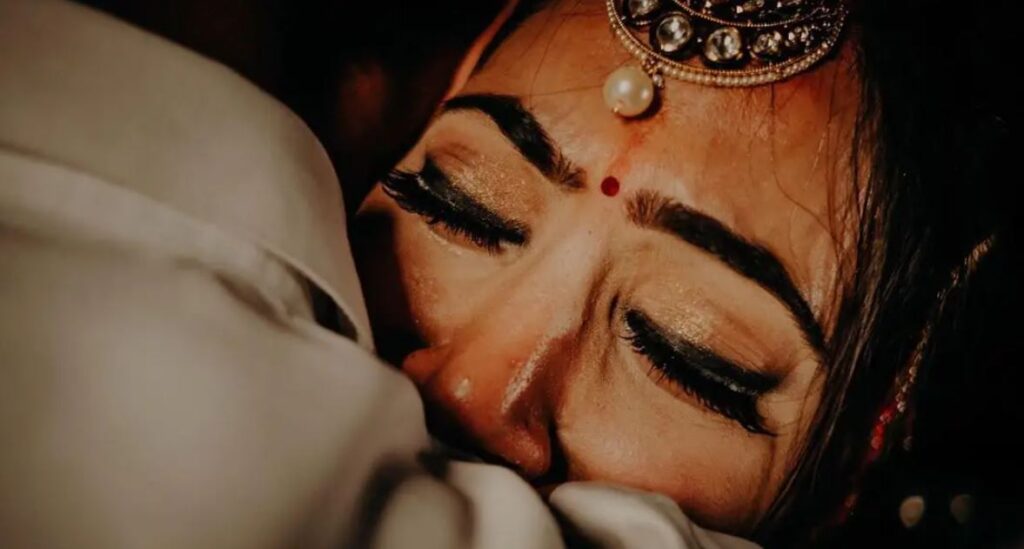
My daughter who is finishing high school in about a year is already talking about moving out for college. It feels so unfair to me that I only got to have her living with me for two decades of her life. I often ask her to stay in our house and go to college locally but she rightfully responds by telling me that I was the one always encouraging her to go wherever she wanted, to build whatever life and career she dreams of. I know I will have to fight back my tears the day when she leaves for college. As a Pakistani father, this day of being separated from my daughter would have come much later if I was in Pakistan, that is when she would have been married, but now living here in the US, I will have to see this day much sooner. But the bright side is that I will not be crying on her wedding day.
The Bed Jumps
This tradition is probably not very widely practiced in the country but more belongs to our local area. When the groom is brought in to see the bride on the day of the Baraat, a basic wooden bed is brought in. This is the kind of bed called a “Charpoy.” Since our country and region had been under British rule, if you open an Urdu dictionary you will now see not an insignificant number of words that are derived from the English language. But I have a suspicion that this word, as it is found in the Oxford Dictionary has been derived by English, from Urdu. “Char” means four and “pai” means feet. This is a simple bed with a wooden frame with ropes intertwined between the wooden sides. That makes it a “Charpai” (Four Feet.) The English word “Charpoy” is a derivation from that.
Here a charpai is brought in which is beautified with flowers and confetti. The groom is made to sit in the charpai and the men surround it and lift it up and jump the groom up in the air along with the charpai. My brother happens to be a man of size so the charpai was quite heavy to begin with. I went forward to lend a hand. You cannot stand back and just watch because it is a matter of showing that you are a tough man. Some other men also came forward.
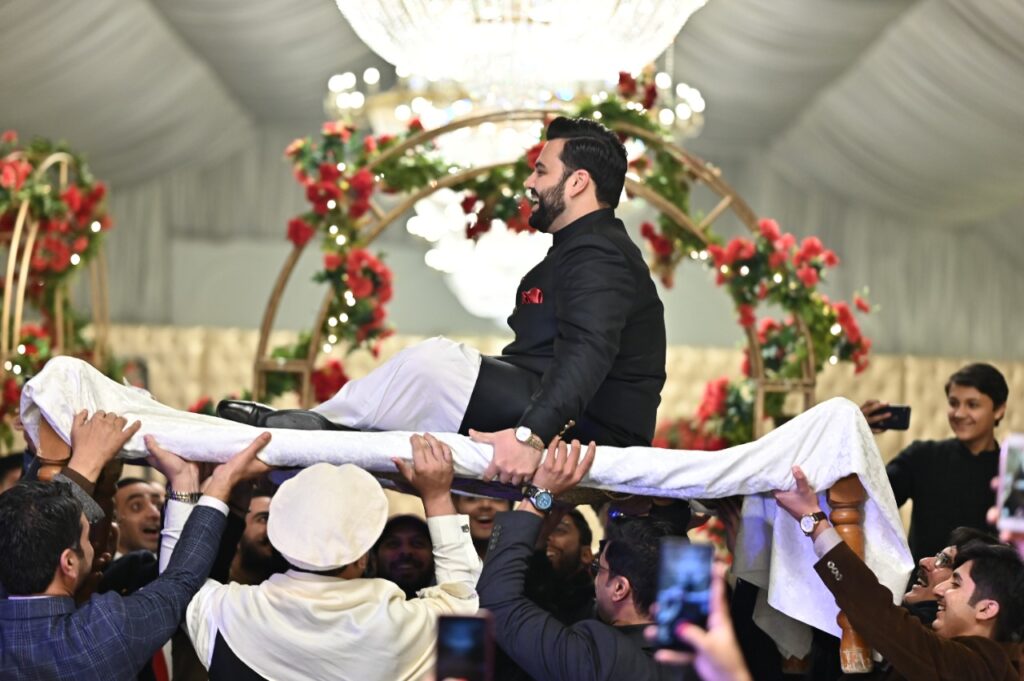
As we gave the first jump, the bed swung and instead of going straight up, got lopsided. As we looked, that was the side held by all little kids who looked plenty in number but did not have much in terms of collective strength. We quickly balanced the weight of the charpai amongst the adults and after just one or two jumps, the bed started getting heavier and heavier with each jump. Our muscles started tiring quickly and I realized that the adults were withdrawing one be one. Now only myself and a couple other guys were left lifting it up. Finally I yelled, “put it down, down” while the surrounding people were screaming asking us to keep going on because they were having fun.
We still were able to put the groom back on the floor along with the charpai. I was relieved that the heavy work was over but then someone put a small kid on the charpai and we were expected to give him jumps too. The same cycle repeated and now come to find out that no child wanted to be left behind. We kept at this tiresome for us but fun for others tradition. At the end of it, I had sweated under my fancy clothes and felt like I just finished a strenuous gym workout.
Other traditions may have some superstitious meaning behind them but I still fail to understand the story behind this one except for the groomsmen having rowdy fun.
Sit a boy, in the bride’s lap, so that she bears a boy
In this tradition, a young boy, usually a preteen, is made to sit in the lap of the bride. This is supposed to be a wish that the bride will have a son as her first child. My American-born and raised kids were quick to point out the sexism and to express their shock at the inappropriateness of this tradition, in their eyes. Now a lot of questions can be raised in today’s world but there is no denying the fact that gender choice for children has remained a prevalent issue perhaps ever since humans have been around. We still remain confused about gender issues and people differ vastly in their opinions about which traditions to rectify and what issues to accept and liberalize. When my daughter asked me if this tradition should continue, I told her that I’m not the one to stop a tradition. I can say whether I like it or not but I cannot stop other people from thinking what they have been thinking for hundreds and thousands of years.
How a wedding feels in the days of social media and cellphones.
One thing that was obvious was that it felt like every move was being made in order to be filmed and photographed. The photographers were constantly instructing everyone to pose here and there. It would often even come in the way of spontaneity. For any of the traditions I described above, you had to wait for the cameraman’s instructions. If you went too fast, you had to either slow down or even repeat a certain tradition. Long pauses came in the middle of a certain ceremony or tradition if the lighting or standing arrangement was not to the standards of the cameraman. It became annoying to the point that I suggested that the cameramen leave for about twenty minutes. Enough memories had been captured on film but we had not had any unfilmed moments where we all, as a family could just foucs on each other and on enjoying ourselves at this time of merriment rather than being concerned about filming and how our pictures and videos will come out. My request was instantly rejected by almost everyone because looks like people liked it that way. They wanted to be filmed continuously and were more interested in the social media depiction of the event than enjoying the current moment. I concluded in my mind that perhaps humans enjoy the new digital ways more than they enjoy living in the moment and there is no use fighting the new ways of the world.
Ever since humans have inhabited the Earth, there have been countless philosophies, religions and ways of living different aspects of life. These can all be very different from each other. However, when it comes to how a man and a woman should live together, marriage is the only way that humans have come up with, as a legitimate practice in any society. All countries, cultures and religions require men and women to be married in order to coexist respectfully. But it remains to be a tricky arrangement. There is a famous desi saying that goes something like, “Marriage is like a sweet dessert – those who are eyeing it are salivating and those who have already eaten it are repenting.”
January 17, 2023
Please browse through my blog and read some more by clicking here.


“Man of size” eh…
Very sweet
And very accurate description
Always enjoy reading your blog.
Great work , keep it up.
Would catchup someday Inshallah
Yasser Waheed
One word to define your blog will be ‘excellence’. You shared the most accurate details and great information, I could literally relate to each and every sentence of the blog. Brilliant work, keep it up. Loads of love
Very nicely portrayed wedding . Being a doc i always wonder how cud be a a man of medicine co relate with literature in a well mannered way ..explaining from mehndia to doodh pilayi and n many of our pakistani pure desi rituals Sir you have explained everything very well.. besides the fact …what happens after these good days is reality not always but harsh realities with one in every third . Aneways a nice blog bohut maza aya seems like we are enjoying wedding ourselves bein a part of it… will surely spread a word of your blogs to my juniours so thry should know a doc could be a philosopher a teacher a reader and todays worlds blogger too.. many congratulations for brother wedding n blogg … kmcites always makes our heads up when we as docbeing working in other city hospoitals . Thank s😊
“Man of size” , groom might take it as an offence!😊
Very well written and beautiful scribbling of the event!